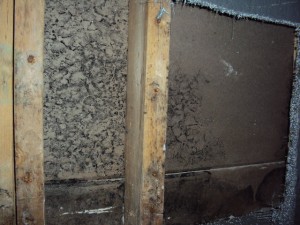Have you got Mould in your House?
Posted by / / No responses Do YOU have Mould in your House?
Do YOU have Mould in your House?
Did you know that many homeowners do not even know they have mould in their home until it shows up in a home inspection? Do you have mould in your house? It can be devastating and costly because the Buyer may opt to not proceed with the purchase of your home OR you may have to remediate the mould problem and it can be expensive.
THE WILDING TEAM had two homes in 2012 that had mould in the attic and we were able to continue with the sale of the home after a call to a company we work with that deals with mould removal.
What is mould?
Mould is microscopic organisms or fungi that are found virtually everywhere both indoors and outdoors and your home might have it too. Mould inside your home is caused from moisture and can cause property damage and have a negative impact on your health.
It is generally orange in colour but there could be black mould in your grout area of your tub, or around your bedroom windows.
How to Know if YOU Have Mould in your House
Put a spot of bleach on the area and if it loses its colour then it is probably mould. That test works for some types of mould however there are others that you can’t see. To detect those you need to use your nose—if you detect a musty smell or some people say an “earthy smell”, you likely have mould.
Causes of Mould in your House
Moisture is the major contributor that mould needs to survive and spread. ‘They say’ to eliminate the moisture and poof mould is gone…but is that true?
The truth is that some moulds do not need heavy concentrations of water to survive and may spread on the small amount of moisture absorbed into drywall, paper, wood baseboards, panelling, carpets or even dirt. Most mould however does live in dark, damp places like basements, crawl spaces, foundation leaks, pipe/plumbing leaks or toilet seals from wobbly toilets. If you were to put anything away damp you will notice a smell in a few days. That moisture-induced musty smell can come from anything from sports equipment in bags to under your refrigerator.
Temperatures between 20 degrees Celsius and 30 degrees are perfect for instigating growth of mould and thrives where moisture content is 18% or greater. Mould often grows in areas that do not have air flow such as attics, closets, inside walls, or as mentioned—gym bags (gym bags can be a home owner’s—and real estate agent’s—worst enemy).
How to Rid your House of Mould?
It is impossible to get rid of ALL the mould in a home unless you get rid of ALL the moisture…and when we live in a home, take showers and baths, cook, do laundry or have leaky faucets, cracks in the foundation, air tight windows and doors and added insulation in attics—ridding a home of moisture isn’t easy.
What makes it even harder is that home renovations (especially those made by nonprofessionals) can create moisture pockets. This can be from not leaving space in the attic near the edge of the roof so that air flows into and out of your attic, improperly-ventilated bathrooms that vent into other parts of the home, or many other things.
So what does this mean? Well mould removal companies call it mould ABATEMENT…this means that they will find the mould, treat it with chemical and seal it BUT they also tell you that you need to get rid of the sources of moisture.
Who to call?
CMHC (Canada Mortgage and Housing Corporation) recommends getting professional help AND Real Estate Agents recommend getting professional help. The Wilding Team can recommend the company that we used twice last year. They were professional, thorough, used chemicals with special suits and sealed the area off while working on the area. They told the home owners what to do in the future and that was passed along to the new buyers.
WHY get professionals?
Mould, if disturbed, can become air born and land in other areas to contaminate a whole new area. Let the professionals handle it. Small children who breathe faster and more often than adults are very susceptible, as are people with asthma, immune deficiencies, cancer patients and other health-compromised people can easily become ill from mould.
Homeowners and inspectors aren’t the only ones responsible for dealing with mould, us agents are too.
Agent responsibilities in regards to mould:
- IF the homeowner knows there is mould they need to disclose it to their agent
- IF the agent knows or suspects there is mould they need to inform the Seller and the Buyer
- IF the agent for the Buyer under a BRA (Buyer Representation Agreement) knows there is mould they must inform they Buyer
- IF the property underwent a mould abatement the agent must inform the Buyer
What is the Cost of Mould Remediation?
The initial inspection by a home inspector is part of your Home Inspection and if they see or suspect mould then a professional company should be called in to do an evaluation of the situation. The cost to our clients this year was about $2000.00 for the FIRST part of the treatment; IF the second part is needed, which involves sealing the area, that costs around $4,500 and comes with a guarantee for a few years. As you can see this can be rather expensive.
Our suggestions…
- check regular areas of your home that are damp
- check your attic once a year
- remove moisture as much as possible
- keep air flowing to avoid stagnant areas
- repair leaks and watch for moisture stains
- react quickly as dealing with a “little mould” is better than dealing with structural issues to your home